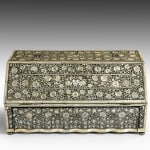Anglo Indian Ebony Table Bureau with Ivory Inlay
INDIA, VIZAGAPATAM, circa 1760
27.5 x 56 x 28 cm
10 ¾ x 22 x 11 in
10 ¾ x 22 x 11 in
451a
Further images
-
(View a larger image of thumbnail 1
)

-
(View a larger image of thumbnail 2
)

-
(View a larger image of thumbnail 3
)

-
(View a larger image of thumbnail 4
)

-
(View a larger image of thumbnail 5
)

-
(View a larger image of thumbnail 6
)

-
(View a larger image of thumbnail 7
)

-
(View a larger image of thumbnail 8
)

The rectangular bureau with a hinged fall (with key) above an arcaded frieze drawer with nine divisions. The interior with nine drawers. The front and sides decorated with engraved ivory...
The rectangular bureau with a hinged fall (with key) above an arcaded frieze drawer with nine divisions. The interior with nine drawers. The front and sides decorated with engraved ivory flowers and foliage. On bun feet.
The decoration on this box is typical of the complex and highly skilled inlaid-ivory work achieved in Vizagapatam in the mid-eighteenth century. Later in the century, the designs changed so that sheets of ivory veneer were used to cover entire pieces of furniture, rather than being inlaid into wood.
Vizagapatam was an important port on the northern part of the Coromandel Coast, where the East India Company established a factory in 1668. The intricate designs of inlaid ivory were inspired by designs of contemporary chintz motifs.
In Furniture from British India and Ceylon, Amin Jaffer writes 'Inventories belonging to the British in India from the second half of the eighteenth century regularly list ivory and ivory-inlaid articles, principally table bureaux and dressing cases, and in some instances these are described as 'Vizagapatam', the use of this term in the vocabulary of notaries indicating that Vizagapatam manufactures were both well known and immediately recognizable.' (Timeless Books, 2001, p.172).
Table bureaux of this form with arcaded frieze drawers were popular in England in the 18th century and were copied in the East.
IMPORTANT NOTE: This item has been registered as exempt from the UK Ivory Act 2018. Ivory declaration submission reference: 87ETMHVV.
The decoration on this box is typical of the complex and highly skilled inlaid-ivory work achieved in Vizagapatam in the mid-eighteenth century. Later in the century, the designs changed so that sheets of ivory veneer were used to cover entire pieces of furniture, rather than being inlaid into wood.
Vizagapatam was an important port on the northern part of the Coromandel Coast, where the East India Company established a factory in 1668. The intricate designs of inlaid ivory were inspired by designs of contemporary chintz motifs.
In Furniture from British India and Ceylon, Amin Jaffer writes 'Inventories belonging to the British in India from the second half of the eighteenth century regularly list ivory and ivory-inlaid articles, principally table bureaux and dressing cases, and in some instances these are described as 'Vizagapatam', the use of this term in the vocabulary of notaries indicating that Vizagapatam manufactures were both well known and immediately recognizable.' (Timeless Books, 2001, p.172).
Table bureaux of this form with arcaded frieze drawers were popular in England in the 18th century and were copied in the East.
IMPORTANT NOTE: This item has been registered as exempt from the UK Ivory Act 2018. Ivory declaration submission reference: 87ETMHVV.








